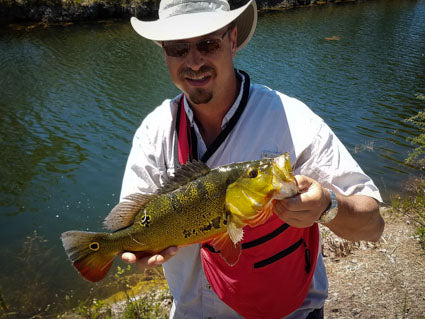Well, we’ve finally gotten to the installment where I actually tell you how to catch some of the South’s most exotic fish. I’m sure you think this is going to be a lengthy diatribe about how spooky and picky these fish can be, thus inflating my already legendary reputation as an accomplished fly angler. Nothing could be further from the truth! And here’s why.
South Florida exotic fish behavior that leads to a strike and hooked fish can be broken down into two distinct categories:
- The fish sees something that looks like food and must eat it.
- The fish sees an enemy that may be a threat and must destroy it.
Pretty simple if you ask me. The trick is being able to tell the difference, selecting the appropriate fly, and presenting it in a manner that will trigger a strike. This may seem obvious to some fishermen, but certainly not to everyone. Many saltwater anglers have never thrown a fly to fish guarding a nest or protecting young. Trout anglers that fish from a drift boat or belly boat rarely see the fish before they hook it because they’re fishing the spot, not the individual fish. For them, sight fishing and closely watching the fish’s behavior may not a big part of the puzzle.
The easiest way to go about this is to pick a fish, then talk about the two distinct behaviors we capitalize on in order to have a successful outing. So, let’s get going.
Peacock Bass
 Peacocks are eating machines and, when in the mood, will take just about any pattern that looks tasty and behaves similarly to their normal prey. They can be holding close to cover, cruising a shoreline, actively pursuing food species, or sitting close to the surface. All it takes, in most instances, is getting the fish’s attention, then keeping the fly moving once they’ve shown interest and are in hot pursuit. Running out of stripping room is a real problem on occasion because the fish will follow right up to the bank at your feet or close to boat side if they don’t truly commit to striking. They’ll take flies on top as well of those below the surface, but flies that sink too quickly or drop below their line of sight rarely get investigated. In other words, they’ll chase and eat just about anything as long as it tries to swim straight away or towards the surface. Fishing for feeding peacocks can be summed up like this; spot the fish, tease it with something that looks tasty, hook the fish. Or not…. It’s still up to the fish.
Peacocks are eating machines and, when in the mood, will take just about any pattern that looks tasty and behaves similarly to their normal prey. They can be holding close to cover, cruising a shoreline, actively pursuing food species, or sitting close to the surface. All it takes, in most instances, is getting the fish’s attention, then keeping the fly moving once they’ve shown interest and are in hot pursuit. Running out of stripping room is a real problem on occasion because the fish will follow right up to the bank at your feet or close to boat side if they don’t truly commit to striking. They’ll take flies on top as well of those below the surface, but flies that sink too quickly or drop below their line of sight rarely get investigated. In other words, they’ll chase and eat just about anything as long as it tries to swim straight away or towards the surface. Fishing for feeding peacocks can be summed up like this; spot the fish, tease it with something that looks tasty, hook the fish. Or not…. It’s still up to the fish.
There are two simple rules when it comes to nesting peacocks.
- Put the fly in their face and keep it there! They will eventually become irritated enough to try and kill it. It may take a handful of tries, and they may puff at the fly to move it from the nest, but eventually they’ll decide to kill it.
- Nesting peacocks are just too easy. They should be targeted sparingly because they’ll abandon the nest if pestered too much. Catch one of a pair, but never target the remaining fish.
Choose flies that are brightly colored, to convey “danger” to the nest, and are weighted just enough for easy control and placement. That way they remain in the threat zone longer. Avoid trying to set the hook as soon as the fish takes because they’re likely facing you and you ‘ll pull the fly right out of their mouths. Give them a second to turn away and your success ratio will greatly increase.
Tiger Oscars
 Nesting Oscars have never been an obvious target for me. Feeding fish, however, are another story. The key factor to keep in mind when targeting them is the location of their eyes relative to their mouths. Their eyes are positioned high on their heads, looking forward, indicating that they’re always looking for prey to come from above. Any floating spider, ant, cricket, or small popper that lands in the zone will get investigated fully. They’ll slowly rise from below before opening their mouths to suck in food. They’ll casually swim over to take a fly sinking slowly to their level, but will rarely eat something that sinks to the bottom quickly. Once again, keep it in their face. Small minnow patterns actively stripped through the water will get chased and devoured especially if there is competition from other fish in the area. Oscars favor cover and rarely stray very far from floating lily pads, overhanging brush, or cluttered canal banks. Be sure to work close to the bushes. I love dropping a fly on top of a lily pad, then slowly working it along till it drops in the water right in front of a relaxed fish. The fish will suddenly realize it’s a hunter and slam the fly without a second thought.
Nesting Oscars have never been an obvious target for me. Feeding fish, however, are another story. The key factor to keep in mind when targeting them is the location of their eyes relative to their mouths. Their eyes are positioned high on their heads, looking forward, indicating that they’re always looking for prey to come from above. Any floating spider, ant, cricket, or small popper that lands in the zone will get investigated fully. They’ll slowly rise from below before opening their mouths to suck in food. They’ll casually swim over to take a fly sinking slowly to their level, but will rarely eat something that sinks to the bottom quickly. Once again, keep it in their face. Small minnow patterns actively stripped through the water will get chased and devoured especially if there is competition from other fish in the area. Oscars favor cover and rarely stray very far from floating lily pads, overhanging brush, or cluttered canal banks. Be sure to work close to the bushes. I love dropping a fly on top of a lily pad, then slowly working it along till it drops in the water right in front of a relaxed fish. The fish will suddenly realize it’s a hunter and slam the fly without a second thought.
Jaguar Guapote
 Jaguars need to feel secure with a roof over their head and plenty of cover. This allows them to rush out with lightning speed to snatch some innocent prey item before turning tail and rushing back home. You need to be pretty lucky to spot one in open water, so concentrate on brushy shorelines, craggy rock walls, culvert pipe openings, floating grass matts, and other places where fouling or losing a fly is more likely than hooking a fish. A slow sinking spider, nymph, or other buggy pattern that remains where they can see it for a while is a sure winner. Just be ready to put the brakes on the fish to keep it from burying itself in the bushes after the strike.
Jaguars need to feel secure with a roof over their head and plenty of cover. This allows them to rush out with lightning speed to snatch some innocent prey item before turning tail and rushing back home. You need to be pretty lucky to spot one in open water, so concentrate on brushy shorelines, craggy rock walls, culvert pipe openings, floating grass matts, and other places where fouling or losing a fly is more likely than hooking a fish. A slow sinking spider, nymph, or other buggy pattern that remains where they can see it for a while is a sure winner. Just be ready to put the brakes on the fish to keep it from burying itself in the bushes after the strike.
Although we have seen paired up fish seemingly guarding a specific spot, it’s kind of unusual and not something we target often. They will strike out of anger but nothing like peacocks or spotted tilapia.
Mayan Cichlid
 Mayans can be unreasonably difficult one day and the simplest thing ever the next, so take every encounter as a learning experience. They are most likely going to be one of the first fish you take because they inhabit a wide range of water types across the region and because of their varied diets. They’ll eat just about anything you can imagine, recreate, and throw on a fly rod provided you don’t scare the daylights out of them. The trick is to continually change flies and adjust your presentation until you figure out what the hot pattern is for the day. Nymphs, spiders, worms, minnows, bread flies, and everything in between will get hit as long as you initially place it near some type of cover. Mayans love to chase things, so it’s quite possible to strip a fly across the entire width of a canal, only to get the strike at your feet. Fish for them like you would any native panfish with a ramped-up appetite. I once caught fish steadily off a small patch of lily pads (maybe 15 feet wide) along the edge of an otherwise featureless canal. The fly was a simple floating bug that my fishing partner thought too ugly to fish with. It more than made up for its lack of beauty by enticing a strike on every cast for ten or so minutes.
Mayans can be unreasonably difficult one day and the simplest thing ever the next, so take every encounter as a learning experience. They are most likely going to be one of the first fish you take because they inhabit a wide range of water types across the region and because of their varied diets. They’ll eat just about anything you can imagine, recreate, and throw on a fly rod provided you don’t scare the daylights out of them. The trick is to continually change flies and adjust your presentation until you figure out what the hot pattern is for the day. Nymphs, spiders, worms, minnows, bread flies, and everything in between will get hit as long as you initially place it near some type of cover. Mayans love to chase things, so it’s quite possible to strip a fly across the entire width of a canal, only to get the strike at your feet. Fish for them like you would any native panfish with a ramped-up appetite. I once caught fish steadily off a small patch of lily pads (maybe 15 feet wide) along the edge of an otherwise featureless canal. The fly was a simple floating bug that my fishing partner thought too ugly to fish with. It more than made up for its lack of beauty by enticing a strike on every cast for ten or so minutes.
Nesting Mayans can be spotted and targeted with some measure of success once you’ve irritated them beyond the point where they just puff at or try to fan your fly off the nest. They will guard the nest as a pair and take turns trying to scare off the intruder until at some point, one becomes more aggressive and resorts to striking out of anger. Once again, it’s important to keep the fly in the threat zone for as long as possible so that the Mayan has no choice but to kill it. Small rod tip movements used to jiggle the fly without moving it very far are the best way to do this. Actively stripping the fly through the zone moves it too quickly and therefore gives the impression that your fly is no longer a problem.
Spotted Tilapia
 Cruising spotted tilapia can be one of the most frustrating things you’ll ever target. They don’t seem to have any real drive or desire to do anything at all, so we rarely dedicate much time to them when they’re in that kind of mood. Instead, I look for the ones I like to call “Home Bodies.” These are the fish that will spook from a specific piece of real estate and then return quickly, like they have separation anxiety and get homesick. I’ll concentrate my efforts on these fish because I know they’ll keep coming back no matter how much I irritate or scare them. Pay close attention to the fish’s color once you’ve made a number of casts. Their throats will turn ruby red when truly upset. That color change becomes more obvious with time and irritation level so keep putting the fly right in the middle of the spot they seem to be guarding and eventually you’ll get hooked up. They have an irritating tendency of blowing or puffing at the fly to try to move it from the nesting site, so it might take some patience and stubbornness on the angler’s part to stick with it long enough to induce a strike out of anger. It will happen.
Cruising spotted tilapia can be one of the most frustrating things you’ll ever target. They don’t seem to have any real drive or desire to do anything at all, so we rarely dedicate much time to them when they’re in that kind of mood. Instead, I look for the ones I like to call “Home Bodies.” These are the fish that will spook from a specific piece of real estate and then return quickly, like they have separation anxiety and get homesick. I’ll concentrate my efforts on these fish because I know they’ll keep coming back no matter how much I irritate or scare them. Pay close attention to the fish’s color once you’ve made a number of casts. Their throats will turn ruby red when truly upset. That color change becomes more obvious with time and irritation level so keep putting the fly right in the middle of the spot they seem to be guarding and eventually you’ll get hooked up. They have an irritating tendency of blowing or puffing at the fly to try to move it from the nesting site, so it might take some patience and stubbornness on the angler’s part to stick with it long enough to induce a strike out of anger. It will happen.
Midas Cichlid
 These are the most difficult of all the species I chase with a fly rod down south. Their desire to stay close to the rock walls of the canals is the main reason for this difficulty. Your fly must sink to their level, then move vertically or diagonally along the face of the wall without getting further from it. I’ve learned that casting parallel to and close to the wall and giving the fly time to sink to depth is the best option. Next best is casting perpendicular to the wall and giving it plenty of time to sink until the line is nearly vertical. It can be a lot like vertical jigging for grouper in a reef. Any fly that gets further than 5 feet away won’t be investigated at all. Their diet consists of any small creatures that will fit in their mouth. This includes snails, fish, shrimp, and plant matter. Fly choice is somewhat irrelevant if it’s small and sinks, it should get eaten.
These are the most difficult of all the species I chase with a fly rod down south. Their desire to stay close to the rock walls of the canals is the main reason for this difficulty. Your fly must sink to their level, then move vertically or diagonally along the face of the wall without getting further from it. I’ve learned that casting parallel to and close to the wall and giving the fly time to sink to depth is the best option. Next best is casting perpendicular to the wall and giving it plenty of time to sink until the line is nearly vertical. It can be a lot like vertical jigging for grouper in a reef. Any fly that gets further than 5 feet away won’t be investigated at all. Their diet consists of any small creatures that will fit in their mouth. This includes snails, fish, shrimp, and plant matter. Fly choice is somewhat irrelevant if it’s small and sinks, it should get eaten.
Hopefully you are ready to grab a rod or two, a couple boxes of flies and head south! The key to successfully chasing south Florida exotics is observation before action. In other words, pay attention to the fish’s actions and demeanor, determine the best way of approaching the fish, make the best presentation you can, and then fish the fly as far as you can before trying again. Hookups will come with time and that’s just the beginning of the fun. Trust me!















Comments